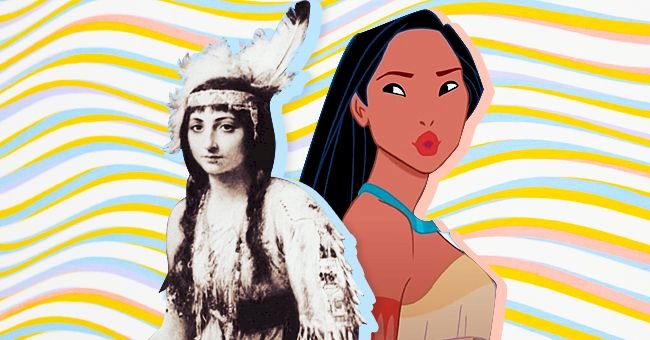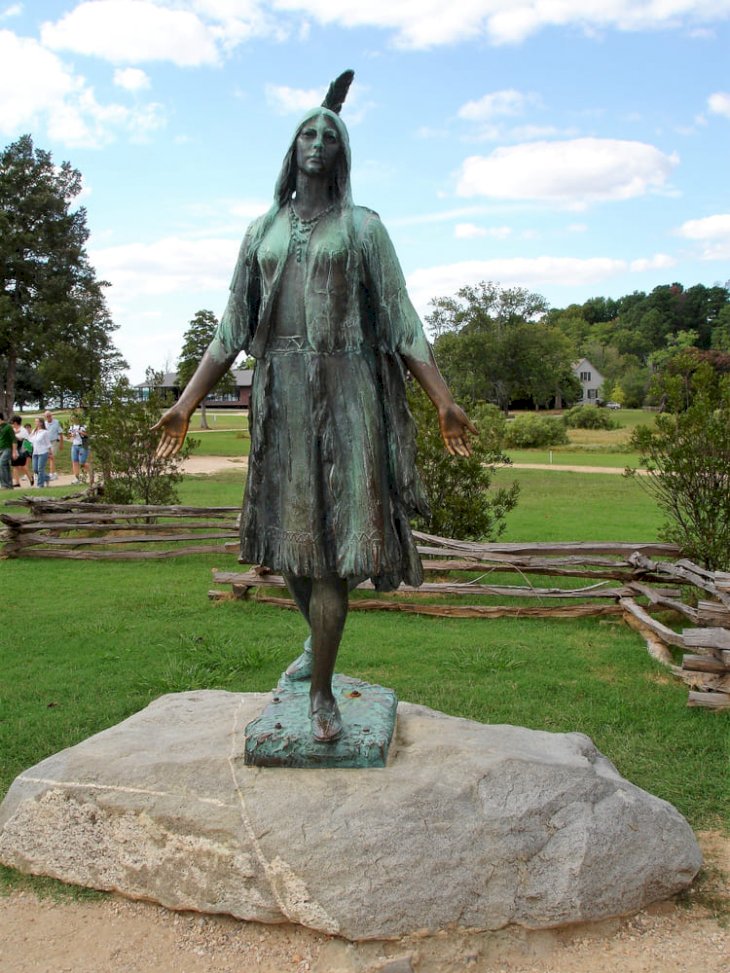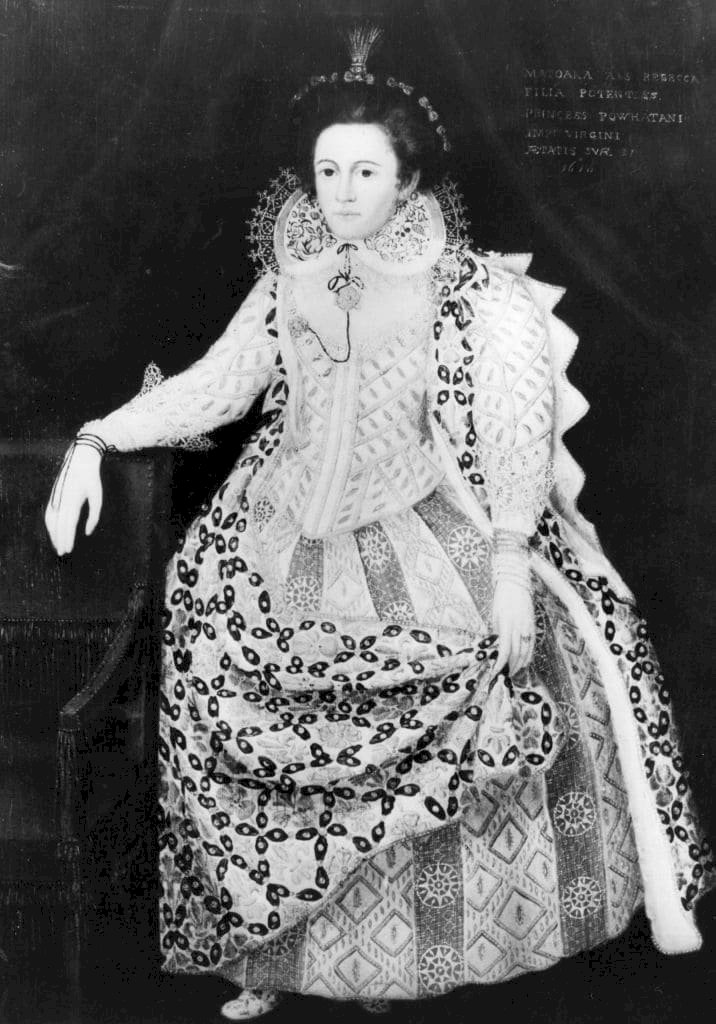
Pocahontas: Everything Disney Didn't Tell Us From The Real Story
Pocahontas is the only Disney princess based on a real person. According to records, the real Pocahontas was reportedly born in the 1500s but Disney doesn't tell her whole story.
Native American Pocahontas was born in 1595 to the powerful Chief Powhatan, the ruler of the Powhatan tribal nation. Disney fans know her as a strong wild spirited woman however, her real story is very different from the popular image.
In reality, Pocahontas was only 10-years-old when Jamestown was founded in 1607. She was selected by her father for a special role because of her intelligence and personality. Here is the real story of Pocahontas.
Pocahontas Matoaka

Getty Images
When she was born Pocahontas was actually named Amonute. She chose to go by the name Matoaka and was reportedly nicknamed Pocahontas (meaning "playful one" or “ill-behaved child” depending on who translate the word) because of her inquisitive nature.
As the daughter of Chief Powhatan, she would have had more luxuries than most. However, she was still expected to learn "women’s work" like farming, cooking, collecting herbs, building a house, making clothes, butchering meat, and tanning hides.
Truly Exploring Her Story
Four hundred years after her death, historians decided to challenge the well-known narrative regarding Pocahontas. In 2017, the Smithsonian Channel released a documentary called "Pocahontas: Beyond the Myth."
The series saw authors, historians, curators, and representatives from the Pamunkey tribe of Virginia, who are the descendants of Pocahontas, come together to piece together their version of the story. They describe her as a spunky young girl who worked as a translator, ambassador, and leader in her own right.
Pocahontas and John Smith

Getty Images
The first English settlers arrived in the Jamestown colony in May 1607. Years later, when all those who could dispute his claims were no more, colonist Captain John Smith wrote the first version of Pocahontas as we know it.
He told a tale of being kidnapped by Native Americans and how Pocahontas, the daughter of a powerful native leader, rescued him from being executed by her father. According to Smith, the tribe was ready to kill him but Pocahontas saved his life.
He went on to say that the Chief then decided to barter with him instead. Smith claimed the meeting ended with the Chief calling him "son" and allowing him to leave safely.
Disputes Against John Smith's Story

Getty Images
However, many historians feel this specific version of events may be overly dramatized especially because Smith wrote different versions of his initial meeting with Chief Powhatan. In fact, even though this narrative of Pocahontas turning her back on her own people and rescuing the English man has been retold for centuries, many believe she never rescued him from peril.
Some historians believe that instead, he had misunderstood a ritual ceremony. Others are more skeptical and believe he simply adapted the tale from a popular Scottish ballad. Historians believe his version was popular because it was flattering to the west.
Camilla Townsend, author of the authoritative Pocahontas and the Powhatan Dilemma and a history professor at Rutgers University, explained the idea to the Smithsonian saying that the story of Pocahontas loving John smith thrived for years is because it portrays a comfortable narrative of history.
"I think the reason it's been so popular—not among Native Americans, but among people of the dominant culture—is that it's very flattering to us. The idea is that this is a ‘good Indian.’ She admires the white man, admires Christianity, admires the culture, wants to have peace with these people, is willing to live with these people rather than her own people, marry him rather than one of her own. That whole idea makes people in white American culture feel good about our history. That we were not doing anything wrong to the Indians but really were helping them and the ‘good’ ones appreciated it."
Pocahontas' Real-Life Role
In actuality, Pocahontas played a very important role in history. Shortly after her initial meeting with John Smith, she was appointed as the Powhatan emissary. Thus unlike in the fairytale, she would not simply wander into Jamestown but visit the town with a group of other Powhatans for official business.
The young girl was in charge of bartering food with the settlers and in 1607 helped successfully negotiate the release of Powhatan prisoners. Unfortunately, a year later, Virginia suffered a horrible drought.

Shutterstock
Tensions Rise
The drought left many settlers starving, diseased and desperate. As a result, they became even more dependent and demanding on the Powhatan causing tensions to rise between the tribe and the settlers.
Eventually, the Englishmen’s constant demands for food were too overwhelming for the tribe. The story revealed that the Powhatans decided to attack the English but Pocahontas reportedly warned Smith of the plan thus saving the English.

Shutterstock
Moving The Capital & Marriage
Following the incident, Powhatan moved his capital farther west. This made it harder for the English to reach and Pocahontas no longer needed to visit Jamestown.
During the move, two Englishmen, Thomas Savage and later Henry Spelman, moved with the Powhatans. When Spelman later absconded to join a different tribe and Pocahontas stepped in to save his life by pleading with her father not to send men to bring him back.
Around this time, Powhatan reportedly decided, Pocahontas was ready to enter adult life. She married a man named Kocoum in 1610. He then sent Thomas back to Jamestown which was the last tie the tribe had with the colony.
Kidnapped by the English
Pocahontas had no contact with the English until 1613. The story is that she was lured and kidnapped on Captain Samuel Argall's English ship during the First Anglo-Powhatan War.
Argall used her as a bargaining chip to negotiate with Chief Powhatan for the release of English prisoners, stolen weapons, and food for the colonist. However, her father only met half his demands and left Pocahontas imprisoned.
Captivity
Pocahontas spent her captivity in the settlement of Henricus. She was placed under the care of a minister named Alexander Whitaker.
He taught her about Christianity, English as well as English culture. She later converted to Christianity and was baptized as “Rebecca.”

Getty Images
Marriage to John Rolfe
Around the same time, she had met the widower and tobacco planter, John Rolfe. Once she converted, the couple decided to marry,
Chief Powhatan and the Virginia governor, Sir Thomas Dale reportedly consented to the marriage. Pocahontas married Rolfe in April 1614 and the marriage brought some peace between the English and the Powhatans.
Journey to England
In 1616, when Sir Thomas Dale sailed to England for the Virginia Company, Rolfe, Pocahontas, their infant son Thomas and a dozen Powhatan Indians accompanied him. This was so that the company could prove they had been converting Native Americans to Christianity.
In London, Pocahontas was seen as a princess. She was referred to as “Lady Rebecca Wolfe” and attended plays, balls and even met the royal family.

Getty Images
To her surprise, she also discovered that Captain Smith was alive and in London. She reportedly called him “father” and chastised him for how he treated Chief Powhatan and her people.
During the trip, the Virginia Company commissioned a portrait of Pocahontas which was the only drawing of her made in person. She was dressed in expensive clothes. It was titled “Matoaka, alias Rebecca, daughter of the most powerful prince of the Powhatan Empire of Virginia.”

Getty Images
Her Passing
In March 1617, Pocahontas, her husband, and son decided to return home. Unfortunately, she fell ill shortly after they set sail and was taken ashore at Gravesend, England. The exact illness she suffered is unknown. She passed away in England and was buried at St. George’s church in Gravesend on March 21, 1617.
Rolfe later returned to Virginia while their son was left with relatives in England. Almost two decades later, at age 20, he would travel to Virginia to claim inheritances from his father and grandfather. He became a successful gentleman tobacco farmer.

Getty Images
Chief Powhatan was devastated at the loss of his daughter and passed a year later. The relations between the Powhatan and Virginia colonists declined following his passing.
So while the life of Pocahontas has been heavily romanticized, it's easy to see why. The written accounts and Native American oral history prove the young girl played a very important role in history.